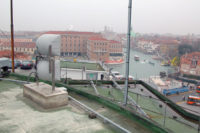Gaining a Wider Mass Notification Reach






There are numerous ways to skin the mass notification cat, according to numerous enterprise security leaders.
Mass notification is a step up from emergency communications and comprises numerous ways to get the word out to the appropriate people inside and outside buildings as well as through computer networks and mobile devices. Solutions, built upon myriad technologies, are fairly common at K-12 school systems, colleges and universities as well as some government and most military facilities. But the various approaches are catching on with corporate, industrial and other enterprises.
Also catching on: use of the mass notification infrastructure to carry nonemergency-related information, sometimes in a two-way mode, for scheduling, marketing and management reasons. There are nuances, however, for some security and life safety executives; one being that too many messages may water down the effectiveness of the critical emergency ones.
Strengthening the Database
And then there is the debate between opt-in and opt-out for people to be part of many mass notification databases. Opt-in, in which people must self-enroll, seemingly is more empowering to the final users. But, with this approach, the percentage of appropriate people in the database is historically low. Opt-out allows people to decide to not participate after the fact in a system that potentially delivers them information in an emergency and that could affect them. Opt-out results in often almost total coverage.
With all the choices for mass notification solutions, every facility has basic and code-required fire and life safety systems.
So it is one sure bet to provide emergency communications through an existing or upgraded fire and life safety system. The National Fire Protection Association (NFPA) spent much time and discussion in the 1990s on emergency communications and mass notification as part of NFPA 72 to go beyond typical indoor and outside speakers and strobes.
There is UL 2572 with requirements that cover discrete electrical control units, communication units, distributed recipient mass notification control units and dedicated targeted individual receiving equipment, high-power speaker arrays, transport products that manipulate the data packets and accessories for mass notification systems to be employed in accordance with NFPA 72.
Then there is the Unified Facilities Guide specification (UFG), for use in specifying construction and upgrading for the military services. The guidelines continue to evolve and change, including the mass notification aspects, notes Leslie “Buddy” Mayo, security manager of the Fort Lee Logistics Exercise and Simulations Directorate. The UFG mandates that, for facilities with 11 or more people, there needs to be voice, fire and mass notification technology.
Getting More
Getting more out of mass notification systems makes sense to a growing number of decision makers, including Linda Schmidt, assistant director of public safety at Burlington County College (BCC), Pemberton, N.J.
BCC selected a multi-modal communication service, Connect-Ed from Blackboard, to initially deliver time-sensitive notifications to students and staff. It provides the ability to reach all students and staff with information and updates within minutes during unforeseen events or emergencies via phone calls, text messages and e-mails. Messages also go out as RSS feeds, displays on A/V monitors and through Facebook and Twitter.
Schmidt says the institution has discovered that sending mass communications via e-mail, text and phone has made it faster and easier to reach her population of non-traditional, commuter students. Truly a team effort, college relations, financial aid, registration, the bursar, student activities and the advising and counseling office came together to develop a communication schedule that has yielded impressive results.
Prior to using the mass notification solution, for example, BCC had about 45 percent of the students paying their bill on payment due date. That has increased to 85 percent, and sometimes 90 percent, a semester. There are database breakouts specific to sectors of students and departments.
Adds Schmidt, “When it comes to opt-in versus opt-out, an opt-out system is the best way to ensure the most people are involved.”
While emergency communications can be achieved through fire systems and dedicated mass notification solutions, there is a similar outcome through upgrading an enterprise’s telecommunications infrastructure.
On the Telecomm Side
For instance, Central Maine Medical Center (CMMC), a 250-bed medical center in Lewiston, saw a need to upgrade its telecommunications infrastructure in a facility expansion. The medical center required a system to deliver enhanced features, provide better management, migrate to voice over IP (VoIP) technology to lower the total cost of ownership and upgrade the architecture to handle increased traffic, including emergency messaging, that would result from the expansion.
A phased approach is used, and it includes replacing existing T1 communicating remote clinic locations with IP networking to provide cost savings by allowing connection over CMMC’s less expensive IP wide area network. The upgrade/migration approach and implementation delivered the next generation technology while preserving CMMC’s existing telecommunications investment. Overall, CMMC will be able to deliver enhanced services expected in the changing information healthcare environment while reducing the total cost of ownership of its telecommunications infrastructure.
Wide area networking also plays a role with well-established emergency phone systems common on many campuses and with the ability to integrate into mass notification solutions.
At the University of Washington, its police department needed an effective and affordable tool to connect and address all areas of the campus community.
Wide Area Emergency Phone Towers
Emergency phone towers were installed across the main campus. Half of those towers feature WEBS, a wide area emergency broadcast system capable of delivering clear audible messages to targeted or entire areas of campus. The majority of the towers replaced older emergency phones, of which there are still many on campus. The towers are placed in accordance with the university’s emergency evacuation plan. Each tower is painted bright blue and equipped with an emergency phone. Blue LED strobe lights are on top of every unit and flash continuously when a unit is activated.
Once they’re activated, the phone automatically dials to the campus police. Personnel immediately know the exact location of the tower. Additionally, security cameras on and around the tower provide a live video feed. Sue Carr, technical services manager for the university police department and who manages IT, records and the dispatch center, says, “In the dispatch center, we are listening to radios and incoming calls all the time. When a unit is activated, we get the call directly into our dispatch center, and we can immediately respond. We call them ‘blue phone activations.’”
Another goal the university wanted to achieve was to improve mass notification capabilities across campus. The WEBS towers, spread out across campus, each have speakers, enabling broadcasting a mass notification message about 1,000 feet in all directions. Police or emergency personnel can broadcast messages from the dispatch center through a single tower or selected group of towers, if the alert is limited to only part of the campus. Using a special key, campus police officers also have the ability to use a microphone in the back of each tower. This allows officers to broadcast messages directly from the back of each unit.
Multiple Approaches
Ray Wittmier, interim chief of the University of Washington Police, thinks that multiple approaches to mass communication is the one best approach for the university. “Everybody recognizes the need for a mass notification system,” he says, “but as we looked at that, we realized that the old, antiquated e-mail method really doesn’t cover everything we need. When we’re trying to send out a message to 65,000 people via one platform, it takes well over an hour. We need multiple ways to deliver that message.”
With some mass notification solutions, they are there to fill a void.
Valencia College in Orlando, Fla., no doubt, has a stunning security infrastructure. It incorporates a multitude of mass notification, access control and emergency communication layers.
Tom Lopez, assistant vice president of safety, security and risk management at Valencia, noticed something missing within the school’s mass notification tools and immediately set out to address it. “We had a void. All of the professional and expert recommendations we received pointed to multilayered mass notification systems. We were lacking one of those layers. “We needed external mass notification devices that could communicate with our campus population.”
So he installed outdoor area WEBS paging units to broadcast clear messages over vast areas. “We’ve used them to notify the campus of severe weather such as tornados. Obviously in Florida, bad weather is a common occurrence. A lot of other institutions use sirens for mass notification. The problem with sirens is that the people who hear them don’t necessarily know what the signal means. With these paging units we can create specific messages to address multiple scenarios. I like that.”
This article was previously published in the print edition as "‘Opt In’ to Mass Notification."
Looking for a reprint of this article?
From high-res PDFs to custom plaques, order your copy today!








